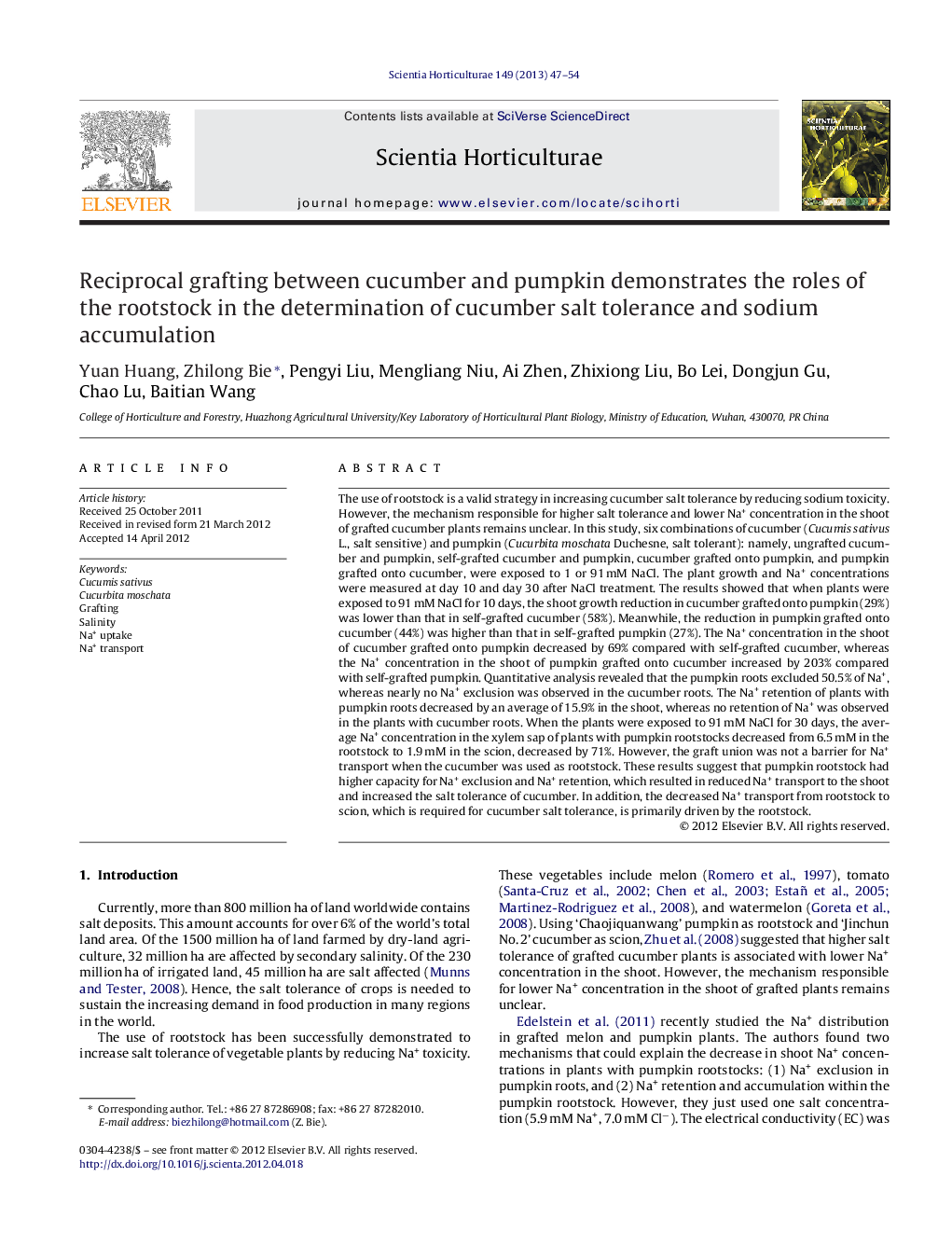| کد مقاله | کد نشریه | سال انتشار | مقاله انگلیسی | نسخه تمام متن |
|---|---|---|---|---|
| 4567479 | 1628849 | 2013 | 8 صفحه PDF | دانلود رایگان |

The use of rootstock is a valid strategy in increasing cucumber salt tolerance by reducing sodium toxicity. However, the mechanism responsible for higher salt tolerance and lower Na+ concentration in the shoot of grafted cucumber plants remains unclear. In this study, six combinations of cucumber (Cucumis sativus L., salt sensitive) and pumpkin (Cucurbita moschata Duchesne, salt tolerant): namely, ungrafted cucumber and pumpkin, self-grafted cucumber and pumpkin, cucumber grafted onto pumpkin, and pumpkin grafted onto cucumber, were exposed to 1 or 91 mM NaCl. The plant growth and Na+ concentrations were measured at day 10 and day 30 after NaCl treatment. The results showed that when plants were exposed to 91 mM NaCl for 10 days, the shoot growth reduction in cucumber grafted onto pumpkin (29%) was lower than that in self-grafted cucumber (58%). Meanwhile, the reduction in pumpkin grafted onto cucumber (44%) was higher than that in self-grafted pumpkin (27%). The Na+ concentration in the shoot of cucumber grafted onto pumpkin decreased by 69% compared with self-grafted cucumber, whereas the Na+ concentration in the shoot of pumpkin grafted onto cucumber increased by 203% compared with self-grafted pumpkin. Quantitative analysis revealed that the pumpkin roots excluded 50.5% of Na+, whereas nearly no Na+ exclusion was observed in the cucumber roots. The Na+ retention of plants with pumpkin roots decreased by an average of 15.9% in the shoot, whereas no retention of Na+ was observed in the plants with cucumber roots. When the plants were exposed to 91 mM NaCl for 30 days, the average Na+ concentration in the xylem sap of plants with pumpkin rootstocks decreased from 6.5 mM in the rootstock to 1.9 mM in the scion, decreased by 71%. However, the graft union was not a barrier for Na+ transport when the cucumber was used as rootstock. These results suggest that pumpkin rootstock had higher capacity for Na+ exclusion and Na+ retention, which resulted in reduced Na+ transport to the shoot and increased the salt tolerance of cucumber. In addition, the decreased Na+ transport from rootstock to scion, which is required for cucumber salt tolerance, is primarily driven by the rootstock.
► Reciprocal grafting was used to study the rootstock in determination of cucumber salt tolerance and sodium accumulation.
► The pumpkin rootstock had higher capacity for Na+ exclusion and Na+ retention, resulted in a reduced Na+ transport to the cucumber scion.
► The decreased rootstock to scion Na+ transport, required for cucumber salt tolerance, is primarily driven by the pumpkin rootstock.
► The graft union was not a barrier for Na+ transport when cucumber was used as rootstock.
Journal: Scientia Horticulturae - Volume 149, 4 January 2013, Pages 47–54